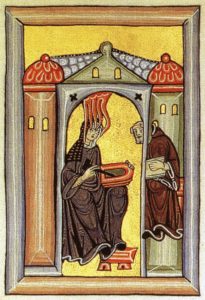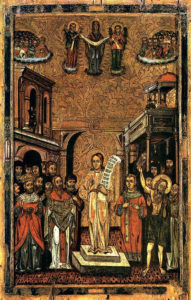Only in Lent Madness will you find a 12th century mystic facing off against a 6th century hymn writer. Well, maybe you can find a matchup between the likes of Hildegard of Bingen and Romanos the Melodist elsewhere in the world. But we're dubious.
In yesterday's Biblical battle, Bartimaeus saw his way past Jude 54% to 46%. He'll face the winner of Joanna the Myrrhbearer vs. Junia in the Saintly Sixteen.
Did you know that at the 2020 Rooted in Jesus conference in Atlanta, Presiding Bishop of the Episcopal Church Michael Curry made his Lent Madness predictions? You can hear what he had to say as part of his Way of Love podcast in his conversation with Lent Madness creator Tim Schenck by clicking here. While we encourage you to listen to the entire 17 1/2 minutes, the Lent Madness conversation starts at minute 10.
Hildegard of Bingen
 Hildegard was born in 1098 in the Rhineland Valley and later wrote that she began experiencing visions of God as a child. When Hildegard was eight years old, her parents placed her under the care of Jutta, an anchoress, and she became part of a growing community of religious women attached to the male Benedictine monastery at Disibodenberg. Upon Jutta’s death in 1136, Hildegard was elected as magistra of the growing community of women, whereupon she pressed the head of the Benedictine monastery to allow her community to form a new monastery in Bingen. Despite initial objections, Hildegard ultimately founded St. Rupertsberg monastery in Bingen in 1150 and later a second monastery in Eibingen in 1165.
Hildegard was born in 1098 in the Rhineland Valley and later wrote that she began experiencing visions of God as a child. When Hildegard was eight years old, her parents placed her under the care of Jutta, an anchoress, and she became part of a growing community of religious women attached to the male Benedictine monastery at Disibodenberg. Upon Jutta’s death in 1136, Hildegard was elected as magistra of the growing community of women, whereupon she pressed the head of the Benedictine monastery to allow her community to form a new monastery in Bingen. Despite initial objections, Hildegard ultimately founded St. Rupertsberg monastery in Bingen in 1150 and later a second monastery in Eibingen in 1165.
When Hildegard died in 1179, she left behind three volumes of visionary theology, including her most well-known theological work, Scivias, as well as soaring liturgical compositions and the morality play Ordo Virtutum. Her 400 letters represent one of the largest collections to survive from this period, and her other writings include sermons from four preaching tours, volumes on natural medicine derived from her gardening and healing practice, an invented language, gospel commentary, and many more minor works.
Reviewing the various short biographies on Hildegard, it is apparent that she had a gift for getting what she and her community needed despite the ecclesiastical restrictions of her time. When Hildegard asked for permission to found a monastery in Bingen, she had already laid the groundwork with the Archbishop of Mainz. Later, Hildegard became famous when a papal blessing for a portion of Scivias was construed as papal approval for the wide range of her theological work. Was this an accident or an example of being as wise as serpents, innocent as doves? Either way, it was a milestone in clearing the pathway for Hildegard to become a much sought-after theologian, spiritual advisor, and preacher across northern Europe.
Much more could be said about Hildegard, including her theological notion of viriditas or “greenness,” her understanding of medicine as a form of gardening, and the uniqueness of her liturgical music, but what stands out is her visionary leadership in a time when this was very difficult to achieve.
Collect for Hildegard
God of all times and seasons: Give us grace that we, after the example of your servant Hildegard, may both know and make known the joy and jubilation of being part of your creation, and show forth your glory in the world; through Jesus Christ our Savior, who lives and reigns with you and the Holy Spirit, one God, for ever and ever. Amen.
Romanos the Melodist
 Saint Romanos the Melodist wrote hymns during the sixth century, the golden age of Byzantine hymnography. Most biographical information about him comes from the Menaion, a liturgical book of fixed-date propers in the Eastern Orthodox Church. He is believed to have been born to a Jewish family in Syria and was baptized Christian as a young boy. Later he was ordained a deacon in Beirut, then moved to Constantinople to serve as the sacristan at the Hagia Sophia.
Saint Romanos the Melodist wrote hymns during the sixth century, the golden age of Byzantine hymnography. Most biographical information about him comes from the Menaion, a liturgical book of fixed-date propers in the Eastern Orthodox Church. He is believed to have been born to a Jewish family in Syria and was baptized Christian as a young boy. Later he was ordained a deacon in Beirut, then moved to Constantinople to serve as the sacristan at the Hagia Sophia.
The most important legend about Romanos revolves around a vision of Mary and is indeed the origin story for a whole category of music in the Eastern Orthodox church: the Kontakion. The story goes that Romanos began as a lousy singer and reader of the liturgy, and his fellow clergymen made fun of him. Once, after reading from the psalter, he was so ashamed that he put his head down and fell asleep in the church. Mary visited him in a dream and commanded him to eat a scroll she held in her hand. When he awoke, he went to the pulpit and chanted the hymn for which he is best known, the Kontakion of the Nativity, which is largely a dialogue between the Mother of God and the Magi. The beauty of his singing and the wisdom of the theological lyrics moved all.
Romanos wrote his hymns in Greek, and they are renowned for their linguistic beauty and sophisticated style. Although he is believed to have written more than a thousand hymns, only sixty to eighty are still in existence—and not all of those can be verified as his compositions. Rather than esoteric theologies, the hymns are in language accessible to the laity, and they address the pastoral concerns of the average person, making beautiful and accessible the mysteries of the Christian faith. They celebrate feasts and holy other days as well as saints’ lives and biblical themes. In addition to the nativity, his other notable works include the Last Judgment, the betrayal of Judas, and the martyrdom of Saint Stephen.
He is remembered on October 1 alongside the feast day of the Protection of the Mother of God in the Orthodox Church and is the patron saint of liturgical singers.
Collect for Romanos
O God, whom saints and angels delight to worship in heaven: Be ever present with your servants like Romanus the Melodist who seek through art and music to perfect the praises offered by your people on earth; and grant to them even now glimpses of your beauty, and make them worthy at length to behold it unveiled for evermore; through Jesus Christ our Lord. Amen.
[poll id="280"]
128 comments on “Hildegard of Bingen vs. Romanos the Melodist”
I voted for Hildegard. I have been fascinated by her for a long time. Years ago, I went to a weekend retreat on her in N.C. I also have several books about her. I also have a book written by Mary Sharratt called "Illuminations" (https://www.amazon.com/Illuminations-Novel-Hildegard-von-Bingen/dp/0544106539). It's very illuminating!
Romanos got my vote today because I see in his love of liturgical music the same sense of wonder some of the newer Episcopalians in my Bell Choir have towards our ringing ministry
As a member of our church choir, I'm voting for Romanos. "He who sings, prays twice." I find that singing a hymn is a wonderful (and easy) way for me to praise God, or to feel comforted. Sometimes I struggle to find the words to say a prayer, but then I can usually think of an appropriate hymn to express what I want to say.
Correction: "To sing is to pray twice." - St. Augustine
Voting for Romanos, as he is new to us, and we just finished eating our dinner of Parmesan and black pepper ravioli with meat sauce. Wish we could vote for both, as they’re worthy to move forward.
I really thought I would vote for Hildegard; I have long felt a kinship with my fellow singer of ancient times. Yet now I find there is another singer who is even more ancient. I love the story of Romanos’ falling asleep with shame at his caterwauling in church! Haven’t all of us singers had moments when we wish the sanctuary floor would open up and swallow us! How sad that so many of his melodies are lost to us. They echo somewhere out in space, and it gives me chills to imagine them. Against my own expectations, I have voted for the Kantakion. It wouldn’t be Holy Week without it. Thank you, Brother Romanos!
Thank you for your faithful witness to song itself.
I'm right there with you, Susan! I was sure I would be voting for Hildegard and had never heard of Romanos, but his story is compelling and his music is beautiful. Moreover, I teach elementary school music, which means a constant struggle to teach small children to match pitch (which gets harder every year as parents increasingly neglect their sacred duty to sing with their children). I would welcome Mary's visit to one of my current 2nd grade classes with some of those scrolls!
Scientist, mystic, doctor of the church
Hildegard’s plainchant grew from her research:
Like Ordo Virtutum
No one could dispute ‘em;
So let her legacy no-one besmirch.
I empathize with Romanos' difficulty with pitch! I suffer feom a similar difficulty. My beloved church musician admonished me to sing fully to God; despite what my pew .ates think. I do!
But Hildegard's use of natural medicine from her garden inspires me. I am completing my UC extension Master Gardener training and look forward to following in her footsteps.
I read a novel based on her life, and saw a performance of her Ordo Vertutim. I admired her so much that I named my car Hilda, after her. I voted for her, but I will look up Romano’s hymns.
The information about Romanos referenced that he worked at Hagia Sophia for a time. That reminded me of this piece on NPR from February 22 Morning Edition about the amazing sound qualities of the Hagia Sophia. Here's a link to the piece. Worth a listen. And this is why I voted for Romanos!
https://www.npr.org/2020/02/22/808404928/listen-the-sound-of-the-hagia-sophia-more-than-500-years-ago
I know it’s too late, but I like this quote:
“Perhaps most appealing, in a world dominated by men, and despite all of her apparent strengths, Hildegard expressed the vulnerability of a delicate and fragile nature.”
https://healthyhildegard.com/hildegard-of-bingen-biography/
Hildegard gets my vote today
Again a difficult choice. BUT
Hildegard was a renaissance woman long before the renaissance. She:
Was the first published woman physician. Her textbook of medicine was the standard for 200 years.
Wrote an authoritative book on “Natural History” (i.e., biology, geography, etc.)
Saw amazing visions.
Designed a sewer system for her convent. It is still in use after 800 years.
Composed music for the liturgy.
Argued with (and sometimes scolded) archbishops, popes, and emperors–and prevailed!
Since I am a physician and a priest, I voted for her!
I am also a member of the Society of Ordained Scientists. She should be one of our patrons!
I found Hildegard of Bingen vs. Romanos the Melodist
very educational.
I want to share with you how my children learned to love the piano: https://s96.me/ingenious-way-to-learn-piano-and-keyboard
Kisses!! 🙂
6th century Romanos is a sympathetic melodist, but Hildegard is just so Magnificent!!!